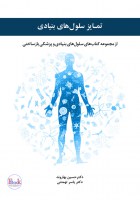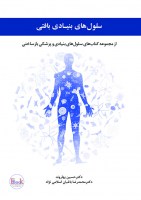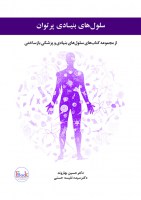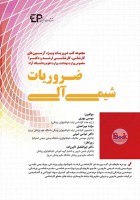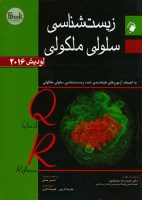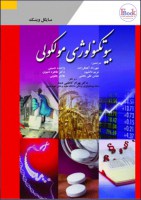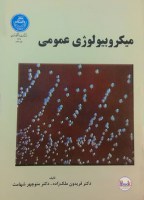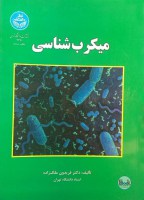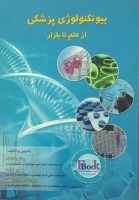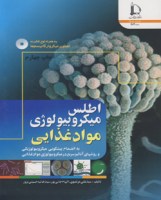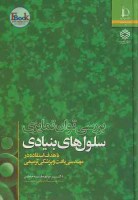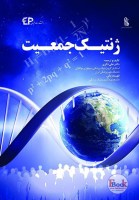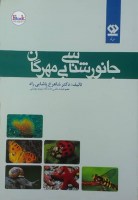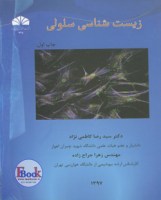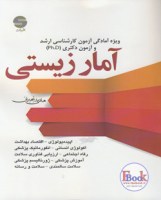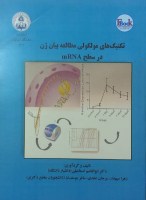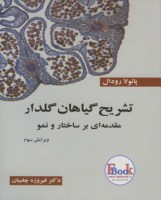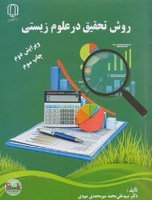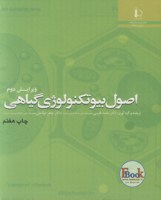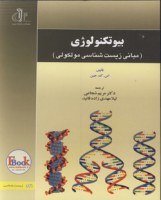دسته بندی
ژنتیک مولکولی واتسون 2014 زبان اصلی
About the Author
James D. Watson is Chancellor Emeritus at Cold Spring Harbor Laboratory, where he was previously its Director from 1968 to 1993, President from 1994 to 2003, and Chancellor from 2003 to 2007. He spent his undergraduate years at the University of Chicago and received his Ph.D. in 1950 from Indiana University. Between 1950 and 1953, he did postdoctoral research in Copenhagen and Cambridge, England. While at Cambridge, he began the collaboration that resulted in the elucidation of the double-helical structure of DNA in 1953. (For this discovery, Watson, Francis Crick, and Maurice Wilkins were awarded the Nobel Prize in 1962.) Later in 1953, he went to the California Institute of Technology. He moved to Harvard in 1955, where he taught and did research on RNA synthesis and protein synthesis until 1976. He was the first Director of the National Center for Genome Research of the National Institutes of Health from 1989 to 1992. Dr. Watson was sole author of the first, second, and third editions of Molecular Biology of the Gene, and a co-author of the fourth, fifth and sixth editions. These were published in 1965, 1970, 1976, 1987, 2003, and 2007, respectively. He is also a co-author of two other textbooks: Molecular Biology of the Cell and Recombinant DNA, as well as author of the celebrated 1968 memoir, The Double Helix, which in 2012 was listed by the Library Of Congress as one of the 88 books that shaped America.________________________________________
Tania A. Baker is the Head of the Department and Whitehead Professor of Biology at the Massachusetts Institute of Technology, and an Investigator of the Howard Hughes Medical Institute. She received a B.S. in biochemistry from the University of Wisconsin, Madison, and a Ph.D. in biochemistry from Stanford University in 1988. Her graduate research was carried out in the laboratory of Professor Arthur Kornberg and focused on mechanisms of initiation of DNA replication. She did postdoctoral research in the laboratory of Dr. Kiyoshi Mizuuchi at the National Institutes of Health, studying the mechanism and regulation of DNA transposition. Her current research explores mechanisms and regulation of genetic recombination, enzyme-catalyzed protein unfolding, and ATP-dependent protein degradation. Professor Baker received the 2001 Eli Lilly Research Award from the American Society of Microbiology and the 2000 MIT School of Science Teaching Prize for Undergraduate Education and is a fellow of the American Academy of Arts and Sciences since 2004 and was elected to the National Academy of Sciences in 2007. She is co-author (with Arthur Kornberg) of the book DNA Replication, Second Edition.
________________________________________
Stephen P. Bell is a Professor of Biology at the Massachusetts Institute of Technology and an Investigator of the Howard Hughes Medical Institute. He received B.A. degrees from the Department of Biochemistry, Molecular Biology, and Cell Biology and the Integrated Sciences Program at Northwestern University and a Ph.D. in biochemistry at the University of California, Berkeley in 1991. His graduate research was carried out in the laboratory of Dr. Robert Tjian and focused on eukaryotic transcription. He did postdoctoral research in the laboratory of Dr. Bruce Stillman at Cold Spring Harbor Laboratory, working on the initiation of eukaryotic DNA replication. His current research focuses on the mechanisms controlling the duplication of eukaryotic chromosomes. Professor Bell received the 2001 ASBMB–Schering Plough Scientific Achievement Award, the 1998 Everett Moore Baker Memorial Award for Excellence in Undergraduate Teaching at MIT and the 2006 MIT School of Science Teaching Award.
________________________________________
Alexander A.F. Gann is the Lita Annenberg Hazen Dean and Professor in the Watson School of Biological Sciences at Cold Spring Harbor Laboratory. He is also a Senior Editor at Cold Spring Harbor Laboratory Press. He received his B.Sc in microbiology from University College London and a Ph.D. in molecular biology from The University of Edinburgh in 1989. His graduate research was carried out in the laboratory of Noreen Murray and focused on DNA recognition by restriction enzymes. He did postdoctoral research in the laboratory of Mark Ptashne at Harvard, working on transcriptional regulation, and that of Jeremy Brockes at the Ludwig Institute of Cancer Research at University College London, where he worked on newt limb regeneration. He was a Lecturer at Lancaster University, U.K., from 1996 to 1999, before moving to Cold Spring Harbor Laboratory. He is co-author (with Mark Ptashne) of the book Genes & Signals (2002), and co-editor (with Jan Witkowski) of The Annotated & Illustrated Double Helix.
________________________________________
Michael Levine is a Professor of Genetics, Genomics and Development at the University of California, Berkeley, and is also Co-Director of the Center for Integrative Genomics. He received his B.A. from the Department of Genetics at University of California, Berkeley, and his Ph.D. with Alan Garen in the Department of Molecular Biophysics and Biochemistry from Yale University in 1981. As a postdoctoral fellow with Walter Gehring and Gerry Rubin from 1982-1984, he studied the molecular genetics of Drosophila development. Professor Levine's research group currently studies the gene networks responsible for the gastrulation of the Drosophila and Ciona (sea squirt) embryos. He holds the F. Williams Chair in Genetics and Development at University of California, Berkeley. He was awarded the Monsanto Prize in Molecular Biology from the National Academy of Sciences in 1996, and was elected to the American Academy of Arts and Sciences in 1996 and the National Academy of Sciences in 1998.
________________________________________
Richard M. Losick is the Maria Moors Cabot Professor of Biology, a Harvard College Professor, and a Howard Hughes Medical Institute Professor in the Faculty of Arts & Sciences at Harvard University. He received his A.B. in chemistry at Princeton University and his Ph.D. in biochemistry at the Massachusetts Institute of Technology. Upon completion of his graduate work, Professor Losick was named a Junior Fellow of the Harvard Society of Fellows when he began his studies on RNA polymerase and the regulation of gene transcription in bacteria. Professor Losick is a past Chairman of the Departments of Cellular and Developmental Biology and Molecular and Cellular Biology at Harvard University. He received the Camille and Henry Dreyfuss Teacher-Scholar Award, is a member of the National Academy of Sciences, a Fellow of the American Academy of Arts and Sciences, a Fellow of the American Association for the Advancement of Science, a Fellow of the American Academy of Microbiology, a member of the American Philosophical Society, and a former Visiting Scholar of the Phi Beta Kappa Society. Professor Losick is the 2007 winner of the Selman A. Waksman Award of the National Academy of Sciences, a 2009 winner of the Canada Gairdner Award, and a 2012 winner of the Louisa Gross Horwitz Prize for Biology or Biochemistry of Columbia University.
مبانی زیست مولکولی و مهندسی ژنتیک گیتی امتیازی
این کتاب شامل 13 فصل زیر است:
اسیدهای نوکلئیک
همانندسازی DNA
ساختمان RNA و نسخه برداری
تکامل RNA
سنتز پروتئین و انتقال آن
تنظیم بیان ژن
اصول و تکنیهای DNA نوترکیب
مهندسی ژنتیک
ژنتیک در سلولهای یوکاریوت
ساختمان و عمل غشاء سیتوپلاسمی
برخی از تکنیکهای عملی در زیست مولکولی
تولید پروتئین های نوترکیب
متاژنومیکس (انگشت نگاری DNA بر ردیابی ژنومیکس محیطی)
مبانی شیمی آلی (نوپردازان)
شیمی آلی در تمام زندگی ما وجود دارد. واکنش و بر هم کنش مولکول های آلی امکان دیدن، بوییدن، و غلبه بر ترس را به ما می دهند. شیمی آلی فنجانی از قهوه مورد علاقه ماست که کافئین موجود در آن ما را بیدار نگه می دارد. شیمی آلی، مولکول هایی برای درمان بیماری ها، دفع آفت های کشاورزی، و تمیز کردن لباس ها در اختیار ما قرار می دهد. کنجکاوی در مورد حیات و موجودات زنده مستلزم داشتن درک بنیادی از شیمی آلی است.
اساس شیمی آلی به میانه سده هیجدهم میلادی بر می گردد، هنگامی که کیمیاگران به تفاوت های تبیین ناپذیر بین ترکیبات به دست آمده از موجودات زنده و ترکیبات حاصل از کانی ها توجه کردند. استخراج و خالص سازی ترکیبات حاصل از گیاهان و جانوران پر دردسر بود. حتی پس از خالص سازی نیز کار کردن با آن ها دشوار بود و خیلی آسان تر از ترکیبات معدنی دستخوش تجزیه می شدند. توربرن برگمن، شیمی دان سوئدی، نخستین دانشمندی بود که در سال ۱۷۷۰م به این تفاوت ترکیبات "آلى" و "معدنی" توجه کرد و واژه های شیمی آلی را برای اشاره به شیمی ترکیبات حاصل از اندامگان زنده به کار گرفت.
بررسی توان تمایزی سلول های بنیادی
کتاب بررسی توان تمایزی سلول های بنیادی نوشته دکتر مریم مقدم متین است. که در انتشارات دانشگاه فردوسی مشهد به چاپ رسیده است.
این کتاب 796 صفحه ای که در سال 1396 برای اولین بار چاپ شده است.
و در 16 مبحث به بررسی توان تمایزی سلول های بنیادی را مورد بررسی قرار می دهد:
فصل 1: مقدمه ای برسلول های بنیادی
فصل 2: سلول های بنیادی مزانشیمی
فصل 3: خون بند ناف منبعی غنی از سلول های بنیادی برای پیوند و درمان
فصل 4: مطالعه تومورهای سلول های جنسی و بررسی تمایز سلول های کارسینو مای شبه جنینی
فصل 5: تمایز سلول های بنیادی به دودمان عصبی
فصل 6: تمایز سلول های بنیادی به سلول های پوستی
فصل 7: تمایز سلول های بنیادی به سلول های استخوانی
فصل 8: تمایز سلول های بنیادی به کندروسیت ها
فصل 9: تمایز سلول بنیادی به سلول های عضله اسکلتی
فصل 10: تمایز سلول های بنیادی به سلول های اندوتلیال عروقی
فصل 11: تمایز سلول های بنیادی به سلول های خونی
فصل 12: تمایز سلول های بنیادی به سلول های سازنده شبکیه
فصل 13: تمایز سلول های بنیادی به سلول های زاینده جنسی
فصل 14: تمایز سلول های بنیادی به هپاتوسیت ها
فصل 15: تمایز سلول های بنیادی به سلول های تولید کننده انسولین
فصل 16: تمایز سلول های بنیادی به دودمان های تروفوبلاستی
در پایان نمایه برای مخاطبان کتاب آورده شده است .
تشريح گياهان گلدار (آییژ)
کتاب تشریح گیاهان گلدار نوشته دکتر فیروزه چلبیان است. که در انتشارات آییژ به چاپ رسیده است.
این کتاب167 صفحه ای در تاریخ 1394 برای اولین بار به چاپ رسید و تا کنون 3 بار وایرش شده است.
در 6 مبحث اصلی زیر، تشریح گیاهان گلدار را مورد بررسی قرار میدهد؛
فصل 1: اندام ها، سلول و بافت ها
فصل 2: ساقه
فصل 3: ریشه
فصل 4: برگ
فصل 5: گل
فصل 6: دانه و میوه
واژه نامه
روش تحقيق در علوم زيستی
با راهاندازي رشته هاي مختلف علوم زيستي در سطوح كارشناسي ارشد و دكتري، ضرورت تدوين كتابي به منظور معرفي مباني، اصول و روشهاي تحقيق بيش از پيش احساس ميشود. اين كتاب با ارائه تعريف تحقيق و تقسيمبنديهاي آن، ويژگيهاي يك محقق خوب را بر شمرده، چگونگي طرحريزي و هدايت مطالعات علومزيستي را به طور مفصل و به زباني ساده به بحث گذاشته است. تاكيد اين كتاب روي چگونگي انتخاب موضوع تحقيق يا پاياننامه، نحوه استفاده از منابع علمي مرتبط با موضوع، جمعآوري دادهها و روشهاي تجزيه و تحليل آماري اطلاعات و تدوين مقالات علمي ميباشد. پيوستهاي متنوع اين كتاب اطلاعات مفيدي را در زمينه شناخت مؤسسات تحقيقات كشاورزي، فهرست منابع علمي رشتههاي مختلف علوم زيستي، چگونگي استخراج منابع از شبكههاي رايانهاي، آحاد موردنياز و ديگر مباحث به خوانندگان گرامي ارائه ميدهد.
خصوصيات كليدي كتاب
- تبيين هدف از تحقيق و سير تحول آن
- بحثهاي جديد در انتخاب و تنظيم موضوع و مسئله تحقيقي
- ارائه تعداد زيادي مثال در زمينه كاربرد شبكههاي رايانهاي و نوشتن منابع علمي مورد استفاده
- درج پيوستهاي مختلف بهعنوان راهنمايي ساده جهت كمك به محققين
اصول بیوتکنولوژی گیاهی
1- مقدمه
2- امکانات آزمایشگاهی
3- محیط کشت ها
4- تکنیک های استریلیزاسیون
5- انواع کشت
6- ریزازدیادی
7-سوسپانسیون سلولس و متابولیت های ثانویه
8- تولید گیاهان هاپلوئید در این ویترو
9- جداسازی و امتزاج پروتوپلاست
10- تنوع سوماکلونال
11- ذخیره ژرم پلاسم و حفاظت در شرایط انجماد
12- ماده ژنتیکی
13- سازمان دهی DNA و بیان ژن
14- کلون کردن ژن
15- روش های انتقال ژن
16- واکنش زنجیره ای پلیمراز (PCR)
17- نشانگرهای مولکولی و گزینش به کمک نشانگر
18- نقشه ژنومی
19- کاربردهای مهندسی ژنتیک گیاهی
20- ملاحظات مربوط به بیوتکنولوژی گیاهی
علوم پایه
کتاب های علوم پایه زیست شناسی شیمی فیزیک ریاضی دانشگاهی





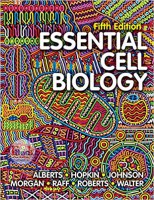

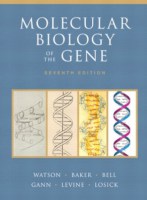
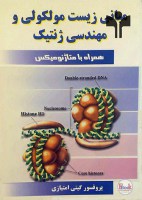
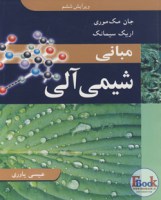
_200x200.jpg)

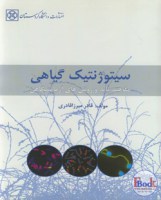
_200x200.jpg)
